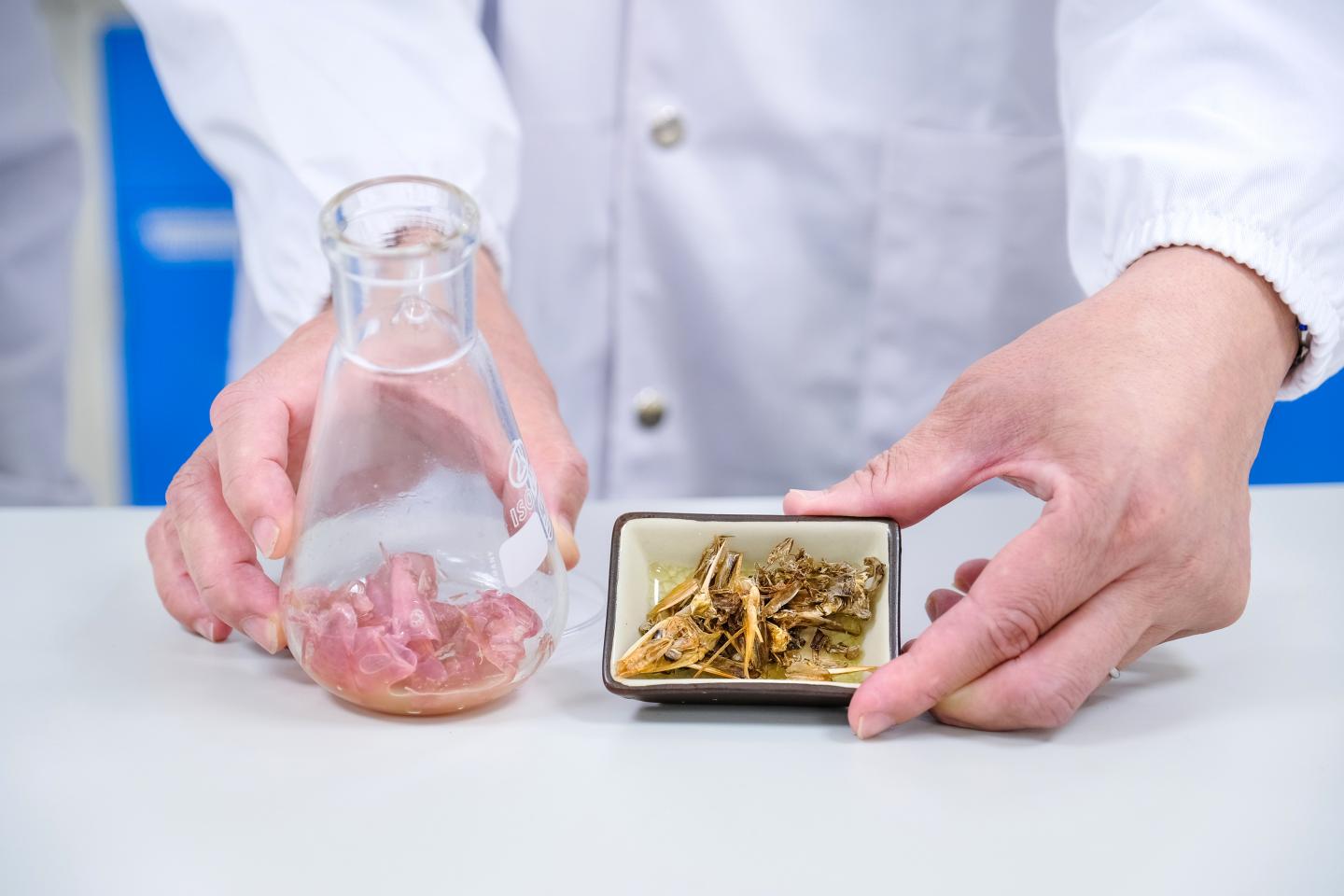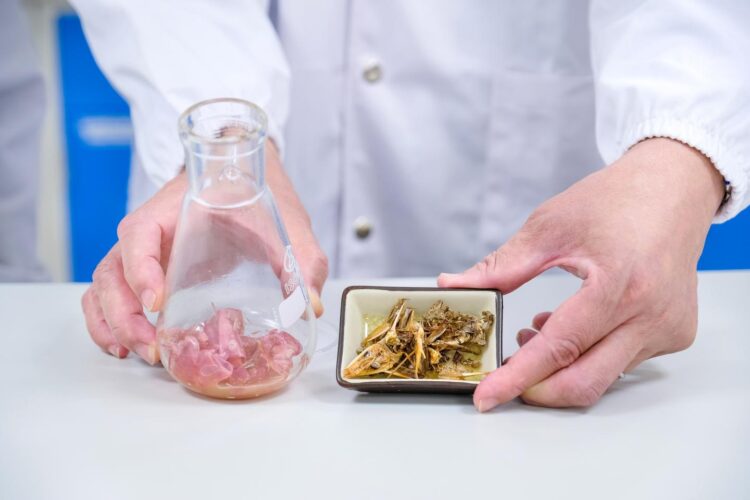
Credit: NTU Singapore
Scientists at Nanyang Technological University, Singapore (NTU Singapore) have developed a green way to create chitin, by using two forms of food waste – prawn shells and discarded fruit – and fermenting them.
Chitin serves a wide variety of uses in the food industry, such as food thickeners and stabilisers, and as anti-microbial food packaging.
The NTU method is more sustainable than current approaches that chemically extract chitin from marine waste, which is costly, consumes large amounts of energy and leads to chemical by-products that may be discharged in industrial wastewater.
Six to eight million tons of crustacean waste are generated annually around the world, with 45 to 60 per cent[1] of shrimp shells discarded as processing by-products.
Professor William Chen, Director of the Food Science and Technology programme at NTU, who led the research, said, “The huge amount of shrimp waste has sparked industrial interest as it is an abundant source of chitin. However, there is a problem in the extraction method, which is both unsustainable and harmful to the environment.
“Our new method takes crustacean waste and discarded fruit waste and uses natural fermentation processes to extract chitin. This is not only cost-effective, but also environmentally-friendly and sustainable, and helps to reduce overall waste,” said Prof Chen.
The team’s findings were published in peer-reviewed journal AMB Express in January 2020.
The NTU team tested ten sources of common fruit waste such as white and red grape pomace, mango and apple peels, and pineapple cores, in various fermentation experiments. They found that fruit waste contained enough sugar content to power the fermentation process that breaks prawn shells down into chitin.
They used ‘X-ray diffraction’ technique to determine the atomic and molecular structure of the chitin created using the new method and its level of purity was measured using a ‘crystallinity index’. The extracted crude chitin samples from prawn shells fermented using fruit waste gave a crystallinity index of 98.16 per cent, which compared to commercial chitin samples with an index of 87.56 per cent. The fermentation process using the sugar content from the fruit waste produced higher quality chitin than the commercial one.
Prof Chen said, “Our research has led to not only higher quality chitin but a more sustainable and environmentally-friendly process too. While the various types of fruit waste produced good results, the sugar from the pomace of red grapes had the best performance. This is also a cost-effective method for industry-scale operations, which could be of potential interest to wineries looking to reduce and upcycle their waste.”
“This research also echoes NTU’s translational research focus, which aims to develop sustainable innovations that benefit society and industry and create a greener future.”
Mr Loo Yuen Meng, Managing Director of Integrated Aqua Singapore Pte. Ltd., who was not involved in the study, said, “The latest innovations developed by Prof William Chen from the Food Science and Technology programme at NTU, is an excellent example of how the expertise from an institute of higher learning can be applied to improve operational efficiency of the food industry while reducing food processing waste. Through a simple fermentation process, the high-value chitin and chitosan recovered from the prawn shells are environment-friendly, and the products can be re-connected back to the food industry.”
By leaving chitin to undergo further stages of fermentation the NTU research team also found they could ferment it further into chitosan, which can be used as a growth enhancer in plant fertilisers, or as a controlled drug delivery system in pharmaceutical treatments.
The NTU team is now exploring ways to use chitosan to enhance previous research innovations such as food packaging created using soybean residue or Okara. This could potentially lead to the development of a more durable cellulose film with anti-microbial and anti-bacterial properties.
Prof Chen is also working with multiple companies to spur the adoption of greener industrial methods in producing chitin and chitosan.
###
[1] Cited in published paper. See Notes to Editor.
Note to Editor:
Paper titled “Microbial extraction of chitin from seafood waste using sugars derived from fruit waste-stream” published in AMB Express on 28 Jan 2020.
Media contact:
Mr Nur Amin Shah
Manager, Media Relations
Corporate Communications Office
Nanyang Technological University
Email: aminshah(a.t.)ntu.edu.sg
About Nanyang Technological University, Singapore
A research-intensive public university, Nanyang Technological University, Singapore (NTU Singapore) has 33,000 undergraduate and postgraduate students in the Engineering, Business, Science, Humanities, Arts, & Social Sciences, and Graduate colleges. It also has a medical school, the Lee Kong Chian School of Medicine, set up jointly with Imperial College London.
NTU is also home to world-class autonomous institutes – the National Institute of Education, S Rajaratnam School of International Studies, Earth Observatory of Singapore, and Singapore Centre for Environmental Life Sciences Engineering – and various leading research centres such as the Nanyang Environment & Water Research Institute (NEWRI) and Energy Research Institute @ NTU (ERI@N).
Ranked 11th in the world, NTU has been placed the world’s top young university for the past six years. The University’s main campus is frequently listed among the Top 15 most beautiful university campuses in the world and it has 57 Green Mark-certified (equivalent to LEED-certified) building projects, of which 95% are certified Green Mark Platinum. Apart from its main campus, NTU also has a campus in Novena, Singapore’s healthcare district.
For more information, visit http://www.
Media Contact
Amin Shah
[email protected]
Original Source
https:/
Related Journal Article
http://dx.





